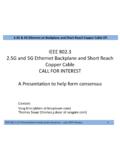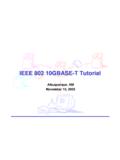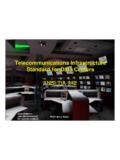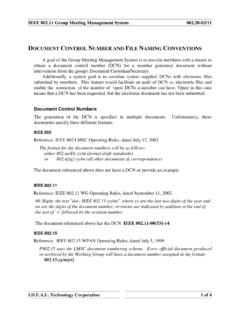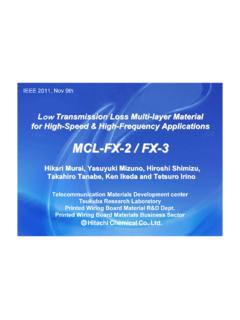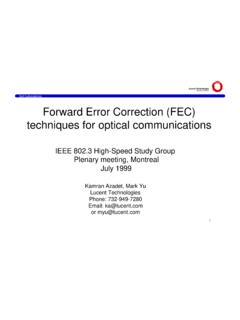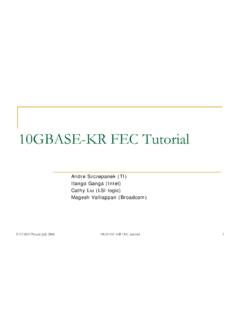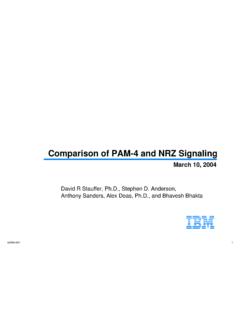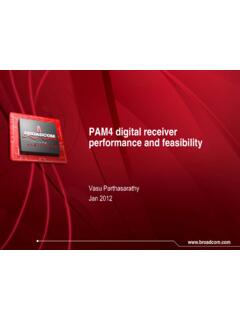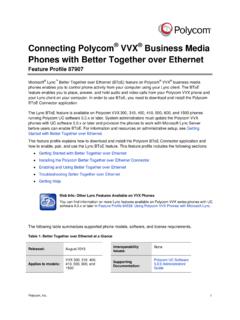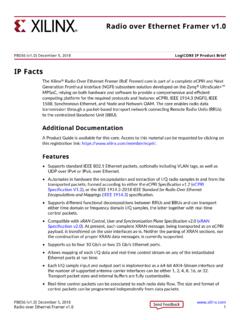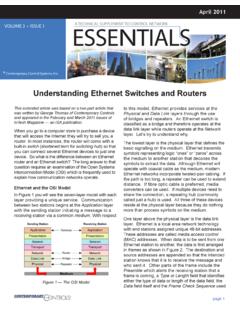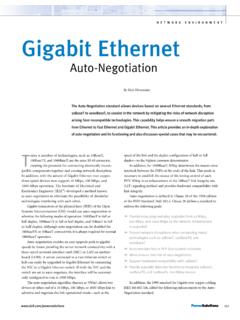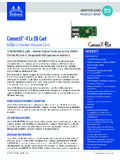Transcription of Power over Ethernet plus Isolation requirements - IEEE 802
1 Power over Ethernet plus Isolation requirementsDavid History 10 BASE2 and 10 BASE5 10 BASE-T DTE Power via MDI Analyses of Differences in DTE Power via MDI RecommendationIEEE Electrical Isolation . The MAU must provide Isolation between the AUI cable and the coaxial trunk cable. The Isolation impedance measured between each conductor (including shield) of the AUI cable and either the centre conductor or shield of the coaxial cable shall be greater than 250 KOhm at 60 Hz and not greater than 15 Ohm between 3 MHz and 30 MHz. The breakdown of the Isolation means provided shall be 250 V ac, Std 10 BASE-T Isolation requirements . The MAU shall provide Isolation between the DTE Physical Layer circuits including frame ground and all MDI leads including those not used by 10 BASE-T. This electrical separation shall withstand at least one of the following electrical strength tests. a) 1500 V rms at 50 Hz to 60 Hz for 60 s, applied as specified in Section of IEC Publication 950 [8].
2 B) 2250 Vdc for 60 s, applied as specified in Section of IEC Publication 950 [8]. c) A sequence of ten 2400 V impulses of alternating polarity, applied at intervals of not less than 1 s. The shape of the impulses shall be s ( s virtual front time, 50 s virtual time of half value), as defined in IEC Publication 60 [11]. There shall be no insulation breakdown, as defined in Section of IEC Publication 950 [8], during the test. The resistance after the test shall be at least 2 MOhm, measured at 500 Std (10 BASE-T) Isolation requirement The MAU shall provide Isolation between the DTE Physical Layer circuits including frame ground and all MDI leads including those not used by 10 BASE-T. This electrical separation shall withstand at least one of the following electrical strength tests. a) 1500 V rms at 50 Hz to 60 Hz for 60 s, applied as specified in Section of IEC 60950: 1991. b) 2250 Vdc for 60 s, applied as specified in Section of IEC 60950: 1991.
3 C) A sequence of ten 2400 V impulses of alternating polarity, applied at intervals of not less than 1 s. The shape of the impulses shall be s ( s virtual front time, 50 s virtual time of half value), as defined in IEC 60060. There shall be no insulation breakdown, as defined in Section of IEC 60950: 1991, during the test. The resistance after the test shall be at least 2 M , measured at 500 10 BASE-T 100 BASE-T PHY references TP-PMD TP-PMD text near identical to 10 BSAE-T 1000 BASE-T used same text as 10 BASE-T Hence 10/100/1000 BASE-T all use same text 10 BASE2/5 updated to same text Only reference test methodfrom 60950 applied as specified in Section of IEC 60950:1991. Section is Electrical strength Section is Test procedure IEEE DTE Power via MDI Up to , the IEEE drafts has similar text This text was changed in response to comment # comment #88 It appears that the requirement in this sub-clause is intended to both require and test separation/ Isolation between "port device circuits" and the "PI" or Power interface(which apparently may be subjected to transients).
4 However, I note that generallythis type of separation is only required by safety standards between different low-voltage secondary circuits when the interface may be routed outside the building, , topologies with so-called outside plant connections. I assume the IEEE working group has adopted such a requirement because some Ethernet topologies may be routed outside plant, , campus environment. If this is so, I note that IEC 60950-1 already has a similar requirement between Safety Extra Low Voltage (SELV) circuits and other circuits routed outside plant ( , TNV-1 telecommunication circuits such as ISDN). However, the test parameters in IEEE and IEC 60950-1 are comment #88 (cont) Also, of IEC 60950-1 anticipates surge suppression may be used in such circuits, so the 2 Mohm/500 pass/fail criteria in lines 22-23 of IEEE are too simplified when compared to the similar wording in of IEC 60950-1 for similar circuits containing surge suppression.
5 It is important to point out the above because (a) IEC 60950 would only require such separation/ Isolation for Ethernet topologies with potential outside plant routing (a companion document to IEC 60950-1, IEC TR62102, Classification of Interfaces for Equipment to Be Connected to Information and Communications Technology Networks, only assumes10 Base5 to be subjected to such transients, not 10 Base2 and 10 BaseT (it hasn't addressed 100 BaseT yet)); and (b) it appears that the exact same Ethernet circuits in the exact same products may end up being subjected to two sets of requirements /tests with different parameters, even though the tests are addressing the same hazards. This does not appear to be an ideal situation for Std Isolation The PSE shall provide electrical Isolation between the PI device circuits, including frame ground (if any), and all PI leads. The PD shall provide electrical Isolation between all external conductors, including frame ground (if any), and all PI leads.
6 This electrical Isolation shall be in accordance with the Isolation requirements between SELV circuits and telecommunication networkconnections in subclause of IEC 60950-1:2001. This electrical Isolation shall withstand at least one of the following electrical strength tests: a) 1500 Vrms steady-state at 50-60 Hz for 60 seconds, applied as specified in subclause of IEC 60950-1:2001. b) An impulse test consisting of a 1500 V, 10/700 s waveform, applied 10 times, with a 60 second interval between pulses, applied as specified in subclause of IEC 60950-1:2001. There shall be no insulation breakdown, as defined in subclause of IEC 60950-1:2001. Conductive link segments that have different Isolation and grounding requirements shall have those requirements provided by the port-to-port Isolation of network interface devices (NID).Differences from previous Add requirement to meet SELV to TNV Isolation Electrical Isolation shall be in accordance with the Isolation requirements between SELV circuits and telecommunication network connections in subclause of IEC 60950-1:2001 DC Test eliminated Test method reference changed Was referencing Electrical strength.
7 Test procedure Now referencing Protection of equipment users from overvoltages on telecommunication networks Insulation breakdown definition changed Was at least 2 M , measured at 500 Vdc Now subclause of IEC 60950-1:2001 Meet SELV to TNV Isolation Does this mean SELV to TNV-1, TNV-2 or TNV-3 IEC TR62102, Classification of Interfaces for Equipment to Be Connected to Information and Communications Technology NetworksIEC TR62102:2001 Table B-1 Telecommunication network classificationsYesNoTNV-3 TNV-1 YesTNV-2 SELVNoOvervoltage for telecommunications network possible?Normal operating voltage in excess of SELV limitsIEC 60950 circuit categoryInterface typeTNV-110 BASE5 SELV10 BASE-TSELV10 BASE2 Meet SELV to TNV Isolation (cont) Assume to mean TNV-1 Hence subclause 60950 C) applies Electrical strength test procedure for c) Either Impulse test 1,5kV or Steady state 1,0Kv IEEE Std subclause Either 1500V Impulse test or 1500V Steady state testOther changes Meet SELV to TNV Isolation Change from referencing test to referencing requirements DC test eliminated 10/100/1000 BASE-T still allow this RF capacitors can cause this to fail Test method reference change Whole of reverenced by subclause already PI Device circuits PSEC ontrollerPHYDC-DCPI leadsRecommendation Add an objective that IEEE Std DTE Power via MDI Isolation requirements be revisited as part of Power over Ethernet plus objectives
